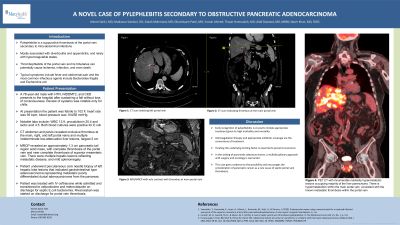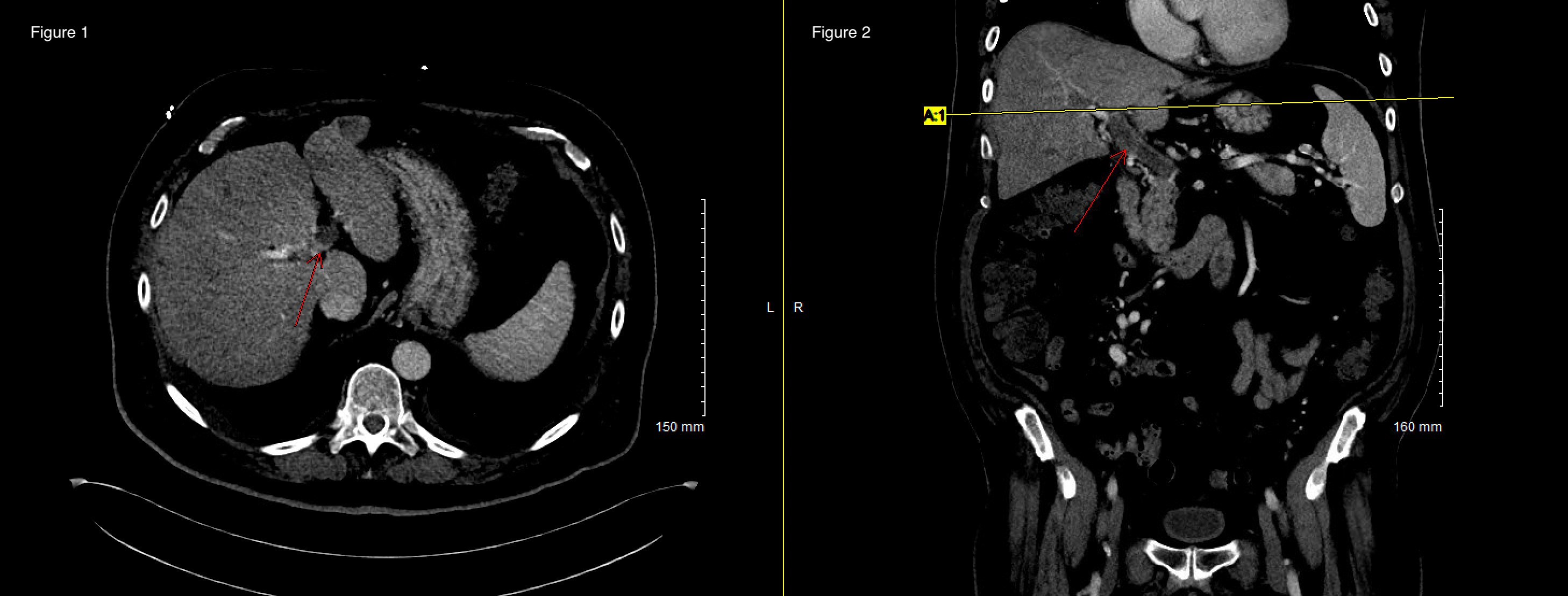Monday Poster Session
Category: Biliary/Pancreas
P1525 - A Novel Case of Pylephlebitis Secondary to Obstructive Pancreatic Adenocarcinoma
Monday, October 23, 2023
10:30 AM - 4:15 PM PT
Location: Exhibit Hall

Has Audio

Ahmet Sakiri, MD
MercyHealth
Rockford, IL
Presenting Author(s)
Ahmet Sakiri, MD, Mudassar Sandozi, DO, Sabah Mahmood, MD, Ghanshyam Patel, MD, Yusrah Ahmed, , Thayer Hamoudah, MD, Altaf Dawood, MD, MBBS, Naser Khan, MD
MercyHealth, Rockford, IL
Introduction: Pylephlebitis is a suppurative thrombosis of the portal vein secondary to intra-abdominal infections, most commonly associated with diverticulitis and appendicitis. Very rarely it is a consequence of hypercoagulable states. Thrombophlebitis of the portal vein and its tributaries can potentially cause ischemia, infarction, and even death. Typical symptoms include fever and abdominal pain and the most common infectious agents include Bacteroides fragilis and Escherichia coli. We present a rare case of pylephlebitis secondary to pancreatic adenocarcinoma.
Case Description/Methods: A 78-year-old male with hypertension, diabetes mellitus type II, and chronic kidney disease presented to the hospital after sustaining a fall without loss of consciousness. Review of systems was notable only for chills. At presentation the patient was febrile to 102 F, heart rate was 93 bpm, blood pressure was 104/56 mmHg. Notable labs include: WBC 13.9, procalcitonin 20.4 and lactic acid 4.5. Both blood cultures were positive for E.coli. CT abdomen and pelvis revealed occlusive thrombus at the main, right, and left portal veins and multiple indeterminate low-attenuation liver lesions, largest 2 cm. MRCP revealed an approximately 1.3 cm pancreatic tail region solid mass, with complete thrombosis of the portal vein and near complete thrombosis of superior mesenteric vein. There were multiple hepatic lesions reflecting metastatic disease, and mild splenomegaly. Patient underwent percutaneous core needle biopsy of left hepatic lobe lesions that indicated gastrointestinal type adenocarcinoma representing metastatic poorly differentiated ductal adenocarcinoma from the pancreas. Patient was treated with IV ceftriaxone while admitted, and transitioned to cefpodoxime and metronidazole on discharge for septic E.coli bacteremia. Rivaroxaban was started on discharge for portal vein thrombosis.
Discussion: Early recognition of pylephlebitis is crucial to initiate appropriate treatment given its high morbidity and mortality. Anticoagulation therapy and appropriate antibiotic coverage are the cornerstone of treatment. Treating the underlying inciting factor is essential to prevent recurrence. In the setting of pancreatic adenocarcinoma, a multidisciplinary approach with surgery and oncology is warranted. This case gives credence to the possibility and encourages the consideration of pancreatic cancer as a rare cause of septic portal vein thrombosis.

Disclosures:
Ahmet Sakiri, MD, Mudassar Sandozi, DO, Sabah Mahmood, MD, Ghanshyam Patel, MD, Yusrah Ahmed, , Thayer Hamoudah, MD, Altaf Dawood, MD, MBBS, Naser Khan, MD. P1525 - A Novel Case of Pylephlebitis Secondary to Obstructive Pancreatic Adenocarcinoma, ACG 2023 Annual Scientific Meeting Abstracts. Vancouver, BC, Canada: American College of Gastroenterology.
MercyHealth, Rockford, IL
Introduction: Pylephlebitis is a suppurative thrombosis of the portal vein secondary to intra-abdominal infections, most commonly associated with diverticulitis and appendicitis. Very rarely it is a consequence of hypercoagulable states. Thrombophlebitis of the portal vein and its tributaries can potentially cause ischemia, infarction, and even death. Typical symptoms include fever and abdominal pain and the most common infectious agents include Bacteroides fragilis and Escherichia coli. We present a rare case of pylephlebitis secondary to pancreatic adenocarcinoma.
Case Description/Methods: A 78-year-old male with hypertension, diabetes mellitus type II, and chronic kidney disease presented to the hospital after sustaining a fall without loss of consciousness. Review of systems was notable only for chills. At presentation the patient was febrile to 102 F, heart rate was 93 bpm, blood pressure was 104/56 mmHg. Notable labs include: WBC 13.9, procalcitonin 20.4 and lactic acid 4.5. Both blood cultures were positive for E.coli. CT abdomen and pelvis revealed occlusive thrombus at the main, right, and left portal veins and multiple indeterminate low-attenuation liver lesions, largest 2 cm. MRCP revealed an approximately 1.3 cm pancreatic tail region solid mass, with complete thrombosis of the portal vein and near complete thrombosis of superior mesenteric vein. There were multiple hepatic lesions reflecting metastatic disease, and mild splenomegaly. Patient underwent percutaneous core needle biopsy of left hepatic lobe lesions that indicated gastrointestinal type adenocarcinoma representing metastatic poorly differentiated ductal adenocarcinoma from the pancreas. Patient was treated with IV ceftriaxone while admitted, and transitioned to cefpodoxime and metronidazole on discharge for septic E.coli bacteremia. Rivaroxaban was started on discharge for portal vein thrombosis.
Discussion: Early recognition of pylephlebitis is crucial to initiate appropriate treatment given its high morbidity and mortality. Anticoagulation therapy and appropriate antibiotic coverage are the cornerstone of treatment. Treating the underlying inciting factor is essential to prevent recurrence. In the setting of pancreatic adenocarcinoma, a multidisciplinary approach with surgery and oncology is warranted. This case gives credence to the possibility and encourages the consideration of pancreatic cancer as a rare cause of septic portal vein thrombosis.

Figure: CT scan indicting left portal vein thrombus (figure 1) and main portal vein thrombus (figure 2)
Disclosures:
Ahmet Sakiri indicated no relevant financial relationships.
Mudassar Sandozi indicated no relevant financial relationships.
Sabah Mahmood indicated no relevant financial relationships.
Ghanshyam Patel indicated no relevant financial relationships.
Yusrah Ahmed indicated no relevant financial relationships.
Thayer Hamoudah indicated no relevant financial relationships.
Altaf Dawood indicated no relevant financial relationships.
Naser Khan indicated no relevant financial relationships.
Ahmet Sakiri, MD, Mudassar Sandozi, DO, Sabah Mahmood, MD, Ghanshyam Patel, MD, Yusrah Ahmed, , Thayer Hamoudah, MD, Altaf Dawood, MD, MBBS, Naser Khan, MD. P1525 - A Novel Case of Pylephlebitis Secondary to Obstructive Pancreatic Adenocarcinoma, ACG 2023 Annual Scientific Meeting Abstracts. Vancouver, BC, Canada: American College of Gastroenterology.
